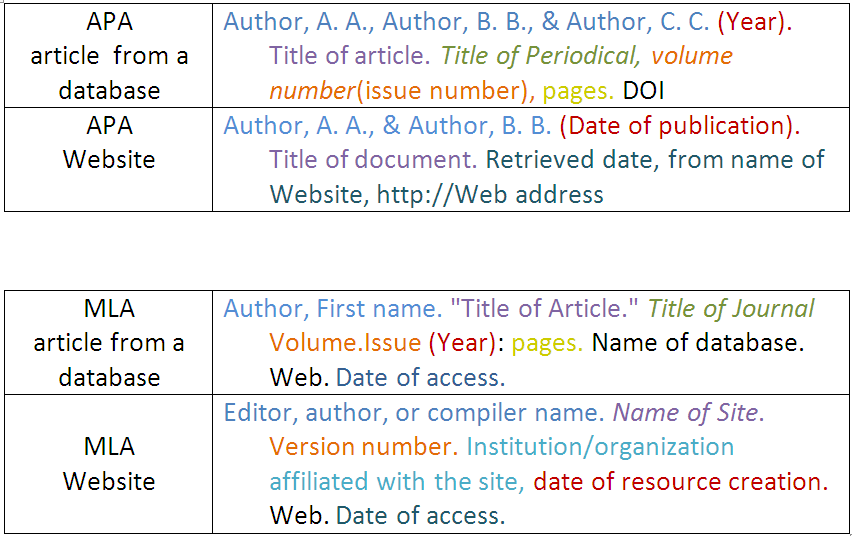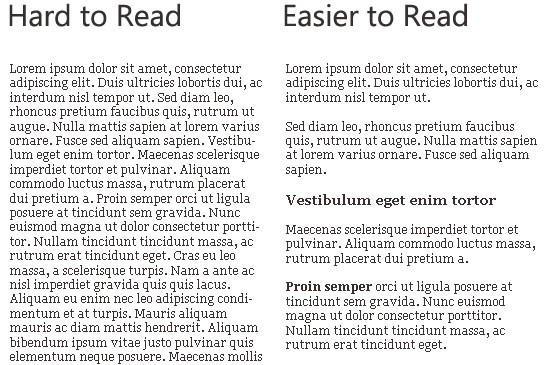Why is formatting so important? It is often neglected by students who think that this is boring and unnecessary: the professor will understand the paper anyway. Unfortunately, for those who are studying and luckily for the readers, adhering to the format is an indispensable thing. Let's consider an example:
This picture demonstrates us how different the same text looks depending on its design. Even though this article is not an academic paper, but you can visually grasp the main purpose of formatting. An essay with paragraphs and proper citing is much easier to read than a paper which resembles a solid sheet of text. As for academic writing, good formatting tells about student’s abilities to:
- Adhere to the rules;
- Simplify the complex;
- Structure;
- Be disciplined;
These 4 skills are quite important for the future career whatever it would be.
What is APA?
APA is an abbreviation of the American Psychological Association. This style of formatting can be frequently found in the academic works dedicated to social or humanitarian issues. There are lots of specifications of citing various sources – books, websites, newspapers, articles or even videos and pictures. Every kind of the citation differs from others, so you need to know more about the most common of them.

Also, a general rule for APA citation represents this structure:
- “Contributors. (Date). Title (Secondary Contributors). Publication Information”
So, you place the author's name first, continue with the date and add secondary contributors if they exist. In the end, you should put publication information. Nevertheless, this is only a basic form. To impress your professor with your formatting skills you need to use specific kinds of citations.
How to Cite a Book
Books citing is not the same according to its type. You should know how to work with 3 kinds of books: actually a book, e-book and book found in a database. For the simple book, the template looks like:
- “Author, A.A.. (Year of Publication). The title of work. Publisher City, State: Publisher.”
For instance:
“Gordon, R. J. (2016). The Rise and Fall of American Growth: The U.S. Standard of Living since the Civil War. Princeton, New Jersey: Princeton University Press””
Be careful with the font: the title of the book should be italicized.

E-book citing
You are free to work with books on the e-reader if it seems more convenient. Nowadays, some publishers bring out only electronic versions of literature works, so let's find out what you should also mention compiling the reference list.
- “Author, F.M. (Year of Publication). The title of work [E-reader Version]. Retrieved from http://xxxxx or doi:xxxxx”
APA Example:
Verbic M. (2011). Advances in Econometrics Theory and Applications. Retrieved from http://www.freebookcentre.net/”
You should write Digital Object Identifier which is frequently used by library databases while mentioning the book from a database.
Rules of Website Citing
Students often cite websites noticing some articles which contain some useful information data for their academic papers. In fact, we use only some content written by an author, not the whole source. However, sometimes there is no author mentioned on the website. So, here we use 2 templates:
- “Author, A.A.. (Year, Month Date of Publication). Title. Retrieved from URL”
or
- “Title. (Year, Month Date of Publication). Retrieved from URL”

For instance:
“BBC – GCSE Bitesize: What is communication? (2017, March 17) Retrieved from
http://www.bbc.co.uk/schools/gcsebitesize/business/people/communicationrev1.shtml”
Working with Periodicals
Periodical could be:
- Academic journals;
- Daily, weekly or monthly magazines;
- Newspapers.
All those sources can be found online and in print, so the rules for their citing are slightly different.
Academic Sources Citing
Another author’s dissertation, thesis or coursework can be also used as a source of information for an academic paper. Some people receive useful information from lectures or conference papers. These papers are usually stored in databases or on specific websites
Here is a template for academic paper cite taken from a database:
- “Last, F.M. (Date published). Title (Doctoral dissertation or master’s thesis). Retrieved from database name. (Accession or Order no.)”
Citing of papers from the internet:
- “Last, F.M. (Date published). Title (Doctoral dissertation or master’s thesis). Retrieved from the URL (Accession or Order no.)”
Let’s provide an example:
“Krishnamoorthy, S.(2017). Alleviation of reentry communications blackout by electrostatic methods (Doctoral dissertation). Retrieved from https://searchworks.stanford.edu/ ”
Other Kinds of Citations
You can cite not only written sources but also photos, videos or even radio broadcasts. The rules for such data origins citation correspond to the general APA fundamentals and it's not complicated to understand how to do it properly. The author's name always goes first, after that you should mention the year of release or publication, the next step is a title. The last two positions are represented by a country and company which is responsible for the release.

As you see, APA citation is a simple matter. The key thing is your attention. Be accurate and considerate to avoid mistakes while compiling a reference list. Also, don’t forget about formatting rules which are connected with the rest of your paper and add lists and tables to simplify the reading. Provide diagrams, pictures and infographics to dilute your text with visual elements It will help to keep the reader and simplify the explanations of the complex issues.


